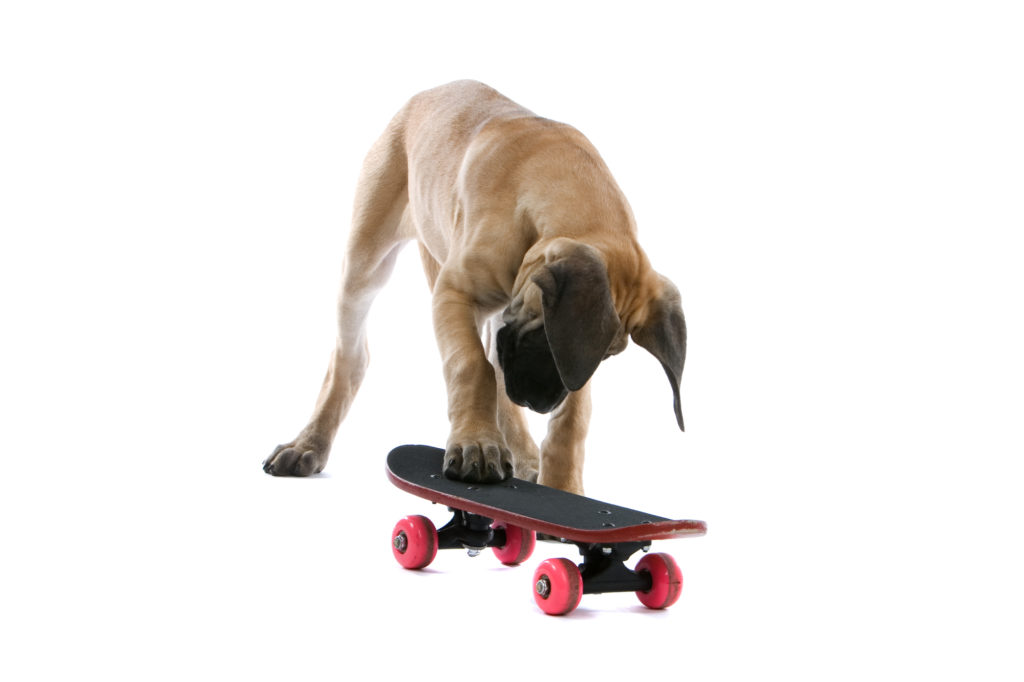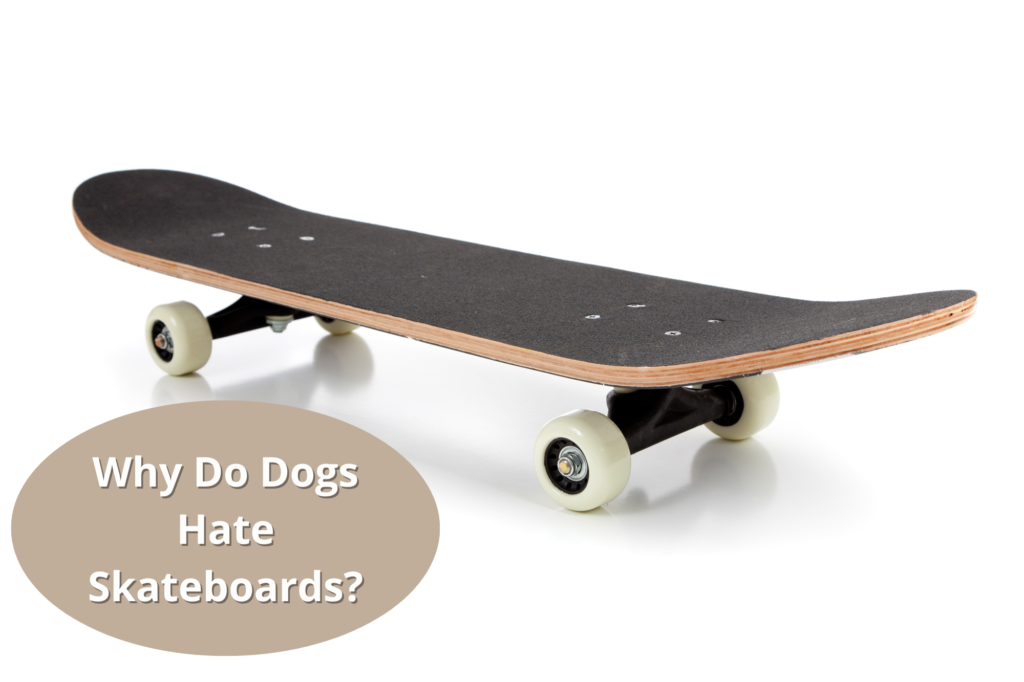Does your dog go absolutely wild when a skateboard rushes innocently past? Your dog might bark, lunge at the skater, or even attempt to give chase with all its might!
Why does this happen? Why do dogs hate skateboards? Read on to find out!
Why Do Dogs Hate Skateboards?
Dogs who hate skateboards tend to feel that way because of their instincts. They may think the skateboard’s movement is enticing to chase or they may be afraid of the unusual appearance and noises made by the item.
3 Reasons Why Dogs Hate Skateboards
1. Their Natural Chase Drive
Dogs have a natural drive to chase moving things and objects. A skateboarder rushing past is an immediate trigger for many dogs’ prey drive.
This is especially true for breeds that have a history of hunting or herding.
Dogs can’t differentiate between something that’s good to chase and something that they should leave alone. For the most part, they take off instinctively without thought!
Many dogs also really enjoy chasing things, which can make it even harder to get them to stop.
2. The Loud Noise
Skateboards rolling across the ground, especially textured ground like asphalt roads and cobbled sidewalks, make quite a lot of noise.
For dogs, this can trigger anxiety that makes them afraid of the causes of that noise, and their fight-or-flight responses are triggered.
Some dogs will choose flight, but many will choose to fight and will run after the skateboard in a panic!
3. A Perceived Threat
Skateboards move quickly, make noise, and aren’t familiar to a dog. This means that a dog can perceive them as a threat to themselves or to their families.
When a skateboard approaches, your dog might strive to protect you by attacking the poor, unsuspecting skater.
How To Stop Your Dog From Reacting Negatively Toward The Skateboard
There are multiple ways to prevent a negative reaction from your dog towards skateboards, but they all involve the necessity of training and slow, gradual exposure.
In other words, you’ll need to introduce your dog to skateboards slowly while training them to remain calm around them.
The goal here is to teach your dog to reframe its negative emotions toward skateboards into a more positive one.
You can do this in a few ways, such as by using treats and praise to reward a dog for staying calm around a skateboard to create a positive association.
Or you might redirect your dog’s attention with a command and toy whenever a skateboard passes until your dog gets used to it and views skateboards more neutrally.
Regardless of your chosen method, it’s a good idea to make sure that your dog knows basic commands like “sit” and “stay” before you attempt to train good behavior around skateboards.
Best Way To Introduce Your Dog To The Skateboard
Step 1: Avoid Unexpected Skateboards
To introduce your dog to a skateboard properly, the first thing you’ll want to do is to reduce the likelihood that your dog will encounter a skateboard in other places.
For example, you might:
- Keep your dog indoors at around the time when skateboarders tend to be active around your house
- Avoid passing areas like skateparks and other popular skateboarding spots when walking your dog
- Go in a different direction when you see skateboarders approaching while you’re out walking your dog
Do note that this step is a temporary one, designed to train your dog to get used to skateboards in a controlled environment first before they encounter one in the outside world.
Step 2: Determine The Right Distraction Or Reframing Method
As mentioned previously, you need to choose a method that you’ll be using to distract your dog from a skateboard and reframe the situation more positively.
You might do this in the following ways:
- Using a loved toy to grab your dog’s attention. When a skateboard comes by, you’ll direct your dog’s attention to a toy.
- Calling your dog to come to you. When a skateboard comes by, you’ll call your dog and issue a series of commands for it to follow.
- Desensitization via praise or treats. When a skateboard comes by, you’ll give your dog praise and treats to develop a positive association with skateboards.
Pick a method that you think will work well on your dog. If you’ve used a reframing or distraction method before, keep using that one!
Step 3: Bring In A Skateboard
When you’re ready to introduce your dog to a skateboard, do it in a calm, quiet environment. Then, bring a skateboard into the room and allow your dog to get comfortable with its presence.
Reward your dog with praise for remaining calm. If they start to get antsy, use the reframing method you’ve chosen to distract them.

Eventually, encourage your dog to approach the skateboard and interact with it. Continue to praise and reward, redirecting your dog with your chosen distraction method when necessary.
It may take a few attempts before your dog feels comfortable touching and sniffing a skateboard.
Do note that dogs who chase after skateboarders because of an activated prey drive may not benefit from interacting too much with the item, as it may cause them to treat skateboards as a toy.
For dogs like this, it’s best to focus on keeping your dog away from the skateboard.
Step 4: Move The Skateboard Around
Once your dog is accustomed to the sight of a skateboard, let them watch you move it around. This will get them more used to the sound and appearance of the skateboard.
Keep rewarding calm behavior and redirecting with your distraction method as needed.
Step 5: Have A Friend Ride By In A Skateboard
Once your dog is accustomed to you moving a skateboard around, have a friend ride by on a skateboard. It’s best to do this on a surface that will make a similar noise to real surfboards outdoors, like on an asphalt road.
Have your friend move slowly first and use the redirection or reframing method you’ve chosen to keep your dog on task.
When the skateboard approaches, you might offer a reward or toy, or simply call your dog’s name and issue a command for patience.
The goal is to redirect your dog before they exhibit any aggressive or negative behavior. Don’t reward your dog for barking accidentally!
If your dog shows bad behavior before you can redirect, restart your attempts by “resetting” your dog, calling for a sit and stay.
Restrict training sessions to 10 or so minutes every day, or the average length of your normal training sessions. Keep practicing until your dog reliably ignores skateboards.
Step 6: Take Them Outdoors
Now it’s time to bring your dog outside and practice in the wild!
You can start more gradually by asking your friend to skate by during a short walk if needed. If not, simply bring your previously practiced techniques out into the open.
When you see a skateboarder approach, use the same redirection and reframing method you used in practice. Once again, reward your dog for successfully remaining calm as the skateboarder passes.
Try to do this in moderation so as not to overwhelm your dog at first. Over time, your dog will be resilient to passing skateboarders.
Conclusion
Most dogs who hate skateboards can’t help their initial reactions to the item. The loud, threatening noise and movement can be perceived as a threat or as something to chase.
By properly redirecting your dog’s attention from skateboarders and introducing skateboards as something neutral or positive, you can train your dog to stop this behavior.

